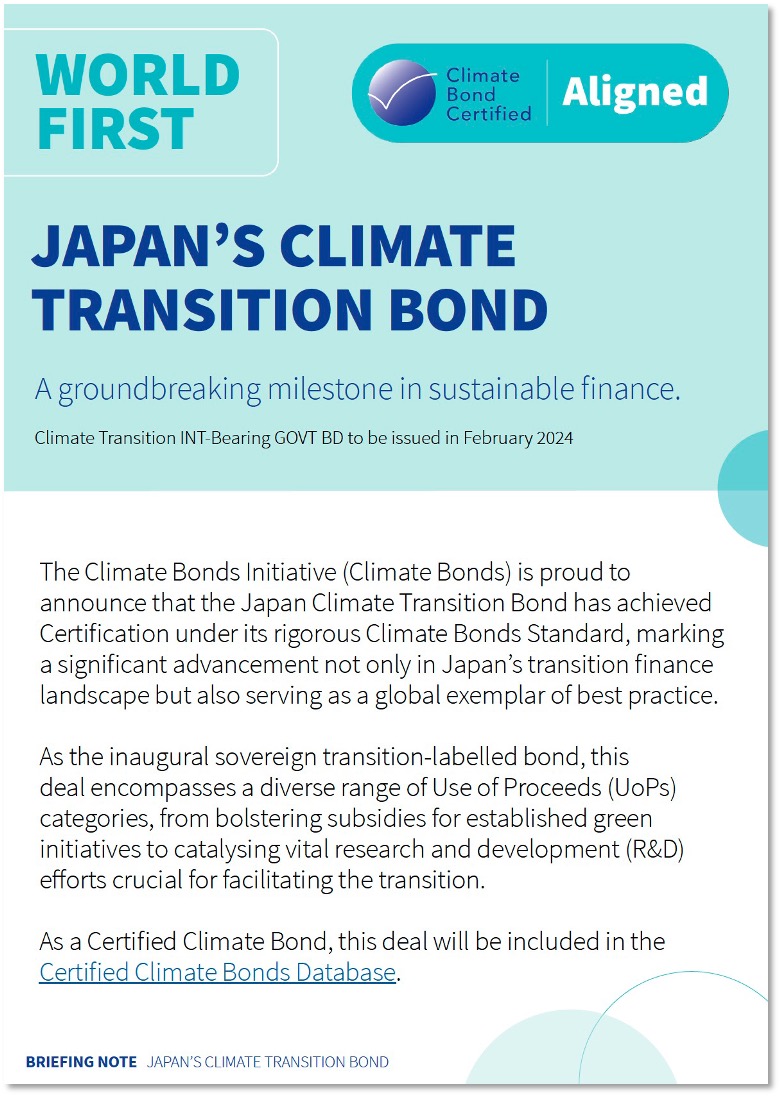A Commentary: 7 key points about the Japan Climate Transition Bond
The Japanese Ministry of Finance (MoF) is currently doing a roadshow for its planned, inaugural, Climate Transition Bond.
The Bond’s proceeds will be applied to funding various parts of the country’s “Green Transformation (GX) Plan”.
The formal commentary we have made available to the MoF is as follows.
7 key points about the forthcoming Japan Climate Transition Bond
UN Secretary-General Antonio Guterres describes the challenge we face as “averting climate catastrophe”, not simply climate "change”. Rapid and substantial emission reductions are vital. Achieving rapid emissions reductions globally will depend on the proliferation of transformational industrial and technology solutions; ensuring they happen at speed will, in turn, depend on strong and persistent enabling public sector activity.
Japan’s first Green Transformation (GX) Plan1 is one example of what needs to be done across all economies, We are conscious that the GX Plan, as with all government programmes from those in the US and Europe to China and India, will need updating and improving on an ongoing basis to ensure targets can be met. Climate Bonds recommendations for the GX Plan are outlined in the October 2023 paper, “Japan: Policies to Grow Credible Transition Finance”. Nonetheless, the fact that such support programmes are now being implemented is of paramount importance and the direction of travel needs to be supported.
But this note is about the forthcoming Climate Transition Bond, which we are pleased to say has a use-of-proceeds commitment that is tighter than the originally announced GX programme, and is one that we are positive about.
(The following Climate Bonds commentary is based on the Use of Proceeds of the inaugural Japan Climate Transition Bond and is not a view on the broader Framework announced earlier, or the underlying GX Plan2.)
We will finalise the detail of our review in the coming week, but at this stage:
- The Bond is expected to be included in the Climate Bonds Initiative Green Bond Database, with the Use of Proceeds consistent with the Green Bond Database Methodology3.
- A substantial part of the Use of Proceeds for the Bond (55.5%) is allocated to research and development of technologies that will support industrial and energy transition in line with emission reduction targets4. We particularly make note that Japan has committed to pursue efforts to limit temperature increase to 1.5°C, including through statements made at the G20 in November 2022 and G7 in May 2023 5 6. A wide range of technology options will be required to restrict global temperature rise to 1.5 degrees, some of which are unproven. Climate Bonds is therefore supportive of research and development spending, particularly for sovereigns, subject to research activities being focused on supporting suitably ambitious emission reductions.
- The remainder of Bond proceeds (44.5%) are allocated to subsidy programmes that support decarbonisation objectives7. The largest allocations of subsidies (81.6%) are directed to silicon carbide power semiconductors for clean transport, electricity storage batteries, and energy-efficiency measures in buildings8.
- A significant part of the Use of Proceeds for the Bond (>39.1 %) is allocated to support deep green activities. This includes R&D for Perovskite Solar Cells and wind, and subsidies for low-carbon transport and batteries9.
- The Bond includes an allocation to R&D for the utilization of hydrogen in the steel-making process and the decarbonization of the thermal process (18.0%)10. Climate Bonds supports this allocation, as it can significantly contribute to the emissions reduction in the steel sector.
- The Bond does not include funding for gas-fired power generation for the electricity network. Climate Bonds especially welcomes this exclusion from the Bond.
- The Bond does not include any funding for operational activities related to ammonia co-firing in coal-fired power plants. The over-arching GX Plan has attracted particular scrutiny around the potential use of ammonia as feedstock in place of coal in operational coal-fired power plants. While this remains a potential component of the GX Plan, funding for operational activities is not included in the Use of Proceeds of this Bond.
Funding for ammonia as a combustion fuel is for research and development only, looking at a wide range of applications, including as a fuel for shipping and exploring the technical feasibility of replacing gas with ammonia or hydrogen.
We welcome research and development towards quickly reducing emissions to meet 1.5°C targets, although, any future funding of operational assets, to be supported by Climate Bonds, would have to be in line with the fossil fuel phase-out timetable in the Net Zero trajectory modelling of the International Energy Agency (IEA), and use low-carbon hydrogen/ammonia.
- The Strategy for Promoting Structural Transition based on Decarbonization (GX Promotion Strategy)
- Climate Transition INT-Bearing GOVT BD to be issued in February 2024
- www.climatebonds.net/files/files/CBI_Method_Criteria_03F.pdf
- Projects 1-17 (Project numbers here and onwards are as indicated in the Second Party Opinionby Japan Credit Rating Agency, released on 16 January 2024)
- www.mofa.go.jp/mofaj/files/100421967.pdf
- www.mofa.go.jp/mofaj/files/100506875.pdf
- Projects 18-24
- Projects 18, 19, 20
- Projects 1, 14, 19, 20, 22, 23, 24
- Projects 7, 8

